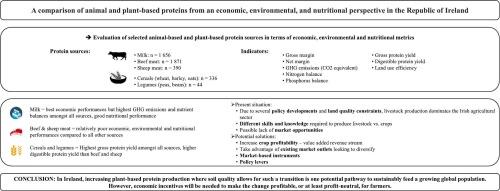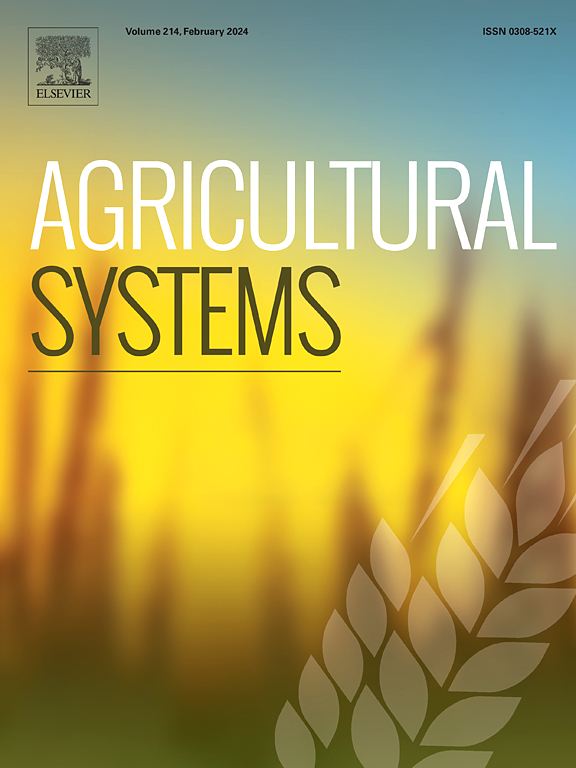A comparison of animal and plant-based proteins from an economic, environmental, and nutritional perspective in the Republic of Ireland
IF 6.1
1区 农林科学
Q1 AGRICULTURE, MULTIDISCIPLINARY
引用次数: 0
Abstract
CONTEXT
Protein is a central component of health and nutrition. The current protein production system is unlikely to sustainably meet the growing global demand for protein. Therefore, alternative sources of protein must be considered.
OBJECTIVE
This study uniquely compares animal-based (milk, beef meat, sheep meat) and plant-based (cereals and legumes) protein production in terms of land usage. The comparison is carried out across a suite of economic, environmental, and nutritional metrics. As land use decisions are taken at the farm level, the analysis adopts a farm gate approach. Focusing on the supply side, consumption is not considered in the analysis.
METHODS
Economic performance is measured through the gross and net margins. Environmental performance is evaluated through farm-level greenhouse gas (GHG) emissions and nutrient (nitrogen and phosphorus) balances. Nutritional performance is measured through the gross protein yield, the protein yield corrected for digestibility and land-use efficiency, i.e., the land needed to generate one kg of (digestible) protein. Results are expressed per hectare and per 100 g of gross and digestible protein to allow for a holistic comparison. The analysis focuses on the Republic of Ireland, a relevant country given the importance of the strong agricultural export focus, the dominance of the livestock sector and the country's ambitious environmental emission reduction targets.
RESULTS AND CONCLUSIONS
Findings indicate that, on a per hectare basis, milk production on dairy farms has the strongest economic performance and highest GHG emissions amongst the products considered. Crops' gross and net margins are less than half that of dairy farms, but they also show the strongest environmental performance generally. Cereals and legumes have the best nutritional performance, from a protein perspective, whereas sheep meat production returned the lowest gross and digestible protein yields per hectare. Arable crops also show the lowest GHG emissions and nutrient balances on a per unit of protein basis.
SIGNIFICANCE
Land-use policies need to be designed holistically, given the complexity of the agricultural sector. Agricultural policy design currently focuses on income support and on the environmental impact of the agricultural sector, but farmers' livelihood and food and protein security need to be safeguarded. Diversifying agricultural production and increasing plant-based protein production in Ireland, a country with a livestock-focused agricultural sector, could contribute to achieving the climate change targets of the country, provided the necessary policy levers are in place.

从经济、环境和营养角度比较爱尔兰共和国的动物蛋白和植物蛋白
内容提要蛋白质是健康和营养的核心组成部分。目前的蛋白质生产系统不可能持续满足全球日益增长的蛋白质需求。本研究对以动物(牛奶、牛肉、羊肉)为基础的蛋白质生产和以植物(谷物和豆类)为基础的蛋白质生产在土地使用方面进行了独特的比较。比较涉及一系列经济、环境和营养指标。由于土地使用决策是在农场一级做出的,因此分析采用了农场门方法。经济绩效通过毛利润和净利润来衡量。环境绩效通过农场一级的温室气体(GHG)排放和养分(氮和磷)平衡进行评估。营养绩效通过蛋白质总产量、经消化率校正的蛋白质产量和土地利用效率(即生产一公斤(可消化)蛋白质所需的土地)来衡量。结果以每公顷和每 100 克总蛋白和可消化蛋白表示,以便进行整体比较。结果和结论研究结果表明,按每公顷计算,奶牛场牛奶生产的经济效益最高,温室气体排放量也最高。农作物的毛利润和净利润都不及奶牛场的一半,但总体而言,它们的环境绩效也最强。从蛋白质的角度来看,谷物和豆类的营养表现最好,而羊肉生产的每公顷总产量和可消化蛋白质产量最低。鉴于农业部门的复杂性,土地使用政策需要全面设计。目前,农业政策设计的重点是收入支持和农业部门对环境的影响,但农民的生计以及粮食和蛋白质安全需要得到保障。爱尔兰是一个以畜牧业为主的国家,在必要的政策杠杆到位的情况下,农业生产多样化和增加植物性蛋白质生产可有助于实现该国的气候变化目标。
本文章由计算机程序翻译,如有差异,请以英文原文为准。
求助全文
约1分钟内获得全文
求助全文
来源期刊

Agricultural Systems
农林科学-农业综合
CiteScore
13.30
自引率
7.60%
发文量
174
审稿时长
30 days
期刊介绍:
Agricultural Systems is an international journal that deals with interactions - among the components of agricultural systems, among hierarchical levels of agricultural systems, between agricultural and other land use systems, and between agricultural systems and their natural, social and economic environments.
The scope includes the development and application of systems analysis methodologies in the following areas:
Systems approaches in the sustainable intensification of agriculture; pathways for sustainable intensification; crop-livestock integration; farm-level resource allocation; quantification of benefits and trade-offs at farm to landscape levels; integrative, participatory and dynamic modelling approaches for qualitative and quantitative assessments of agricultural systems and decision making;
The interactions between agricultural and non-agricultural landscapes; the multiple services of agricultural systems; food security and the environment;
Global change and adaptation science; transformational adaptations as driven by changes in climate, policy, values and attitudes influencing the design of farming systems;
Development and application of farming systems design tools and methods for impact, scenario and case study analysis; managing the complexities of dynamic agricultural systems; innovation systems and multi stakeholder arrangements that support or promote change and (or) inform policy decisions.
 求助内容:
求助内容: 应助结果提醒方式:
应助结果提醒方式:


